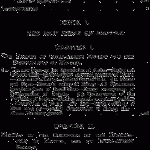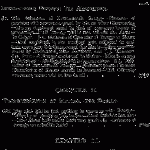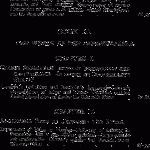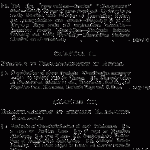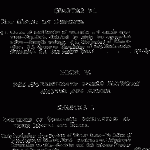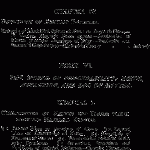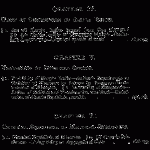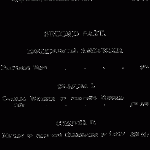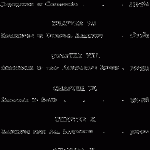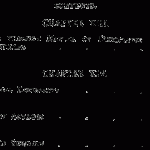The Evolution of Matter by Dr. Gustave Le BON
Table of Contents
Translator’s Preface
Papers by the author published in the “Revue Scientifique”
Introduction
Book I. The New Ideas On Matter
Chapter I -The Theory of Intra-Atomic Energy and the Passing-Away of Matter
(1) The New Ideas on the Dissociation of Matter — Matter not indestructible — Radioactivity universal property of matter — Intra-atomic energy — General Propositions – (2) Matter and Force — Matter as a variety of energy — All phenomena transformation of equilibrium — Energy consequence of condensation of nebula – (3) Consequences of the vanishing of matter — Nothing created, everything perishes — Destruction of matter very slow — Indestructibility of mass must go — Possibly conservation of energy also — Atoms planetary systems.
Chapter II – History of the Discovery of the Dissociation of Matter, and of Intra-Atomic Energy
Author’s discovery of Black Light — Of radioactivity of all bodies — M. Becquerel on the reflection, etc., of uranium rays — Acceptance of the author’s theory by M.de Heen — Unpopularity at outset — Testimony of M. Dastre — Of M. Poincare — Of English writers — M. de Heen’s comparison of the discovery of Black Light with that of x-rays — M. Bohn’s appreciation.
Book II. Intra-Atomic Energy And The Forces Derived Therefrom
Chapter I – Intra-Atomic Energy: Its Magnitude
(1) The existence of intra-atomic energy — Emission of particles with enormous speed by matter when dissociating — Energy developed equal to that of 1,340,000 barrels of gunpowder — This energy within not without the atom — Its origin – (2) Estimate of quantity of energy in matter — That contained in the smallest coin sufficient to send train more than four times around the Earth — Other measurements by Rutherford, Abraham, and Thomson – (3) Forms of energy condensed in matter — Kinetic energy in pinhead = 208,873,000,000 kilogram-meters – (4) Utilization of intra-atomic energy — Useless at present because dissociation of matter cannot be hastened — This difficulty overcome, power will be free to all.
Chapter II – Transformation of Matter Into Energy
Old idea that matter had nothing in common with energy — Difficulty of upsetting this notion — Lord Kelvin’s first view — New ideas only make their way gradually — Influence of prestige on scientific belief.
Chapter III – Forces Derived From Intra-Atomic Energy — Molecular Forces, Electricity, Solar Heat, Etc.
(1) Origin of Molecular Forces — Cohesion, chemical affinity, etc., only explicable as intra-atomic energy – (2) Origin of Electricity — Constantly increasing importance of electricity — Electricity form of infra-atomic energy set free by dissociation of matter – (3) Origin of Solar Heat — Stars not necessarily cooling — Heat lost by radiation may be compensated for by energy liberated in dissociation
Chapter IV – Objections To The Doctrine Of Intra-Atomic Energy
M. Poincare’s M. Painleve’s, and M. Naquet’s objection that no endothermic combination stable — Answer: matter not stable since easily dissociated — M. Gauthier’s confirmation of this — M. Despaux’s objection: quantity of matter and energy in the world invariable — Answer: facts about radium disprove this — M. Duclaud and M. Laisant’s criticisms — Prof. Re’s, Somerhausen’s, and Pio’s opinions — Consequences of sudden dissociation of gram of radium — Ann. Scientifique’s and M. Sagaret’s remarks.
Book III. The World Of The Imponderable
Chapter I – Classic Separation Between Ponderable and Imponderable — Is There An Intermediate World?
Lavoisier’s Definitions and Berthelot’s Approval — Larmor’s reconciliation of ether and nature — Particles emitted during dissociation of matter the link with ether.
Chapter II – Immaterial Basis of Universe: The Ether
Importance of Ether in Physics — Difficulty of defining its properties — Not a gas — Other opinions — Imponderable but condensable — Larmor’s opinion that material molecule only ether.
Chapter III – Different Equilibria In The Ether
All ethereal equilibria very unstable — Vortex ring theory — Explains gravitation — M. Gautier’s opinions on this — M. Benard’s experiments — Matter a particular state of ethereal equilibrium.
Book IV. The Dematerialization of Matter
Chapter I – Interpretation of Dissociation Experiments
(1) The First Interpretations — Crookes’ ultra-gaseous state — Kinetic theory of gases described — Cathode rays really identical with particles of dissociating matter – (2) Interpretations now current — Discovery of x and uranium rays make old explanations untenable — Ionization merely dissociation — Contrasts between ordinary and ionic electricity — Dissociation products identical for all substances.
Chapter II – Products of Dematerialization of Matter
(1) Classification of Above Products — Classification necessary — Can be divided into 6 classes – (2) Characteristics of Dissociation Elements: viz., emanation, positive and negative ions, electrons, cathode rays, and x-rays
Chapter III – Dematerialization of Specially Radioactive Substances
(1) Products of dematerialization of such substances – (2) Alpha rays or positive ions – (3) Beta rays or negative electrons – (4) gamma or x-rays – (5) Semi-material Emanations of Radioactive Substances – (6) Induced radioactivity. All these stages in return of matter towards ether.
Chapter IV – Dematerialization of Ordinary Bodies
(1) Causes of dematerialization – How dissociation proved – (2) Dissociation by light – (3) By Chemical reactions – (4) By electric action – (5) By combustion – (6) By heat – (7) Spontaneous dissociation – (8) Part played by dissociation in natural phenomena.
Chapter V – Artificial Equilibria Of Elements Produced By Dissociation
Possibility of photographing momentary equilibria — Attractions and repulsions of dissociated particles — Globular electricity — The ionic fluid and its geometrical forms
Chapter VI – How Matter Can Dissociate
(1) Causes of modification of molecular and atomic structures — Equilibria disturbed by slight but appropriate action – Acoustic analogy – (2) Mechanism of dissociation – (3) Causes of dissociation of very radioactive substances – (4) Does radium exist?
Book V. The Intermediate World Between Matter And Ether
Chapter I – Properties Of Substances Intermediate Between Matter And Ether
Only irreducible characteristic of matter mass — Variation of mass in case of electric fluid — Kaufmann and Abraham’s researched on this — Particles real link between ponderable and imponderable.
Chapter II – Electricity A Semi-Material Substance
(1) Radioactive and Electrical Phenomena – (2) Elements emitted by Electric machine compared with emission of radioactive bodies — Aggregates identical with alpha, beta, gamma rays — Aggregates also give ultraviolet light — Experiments with Dr Oudin.
Chapter III – Properties of Electric and Material Fluids Compared
Superior mobility of electric fluid — Cornu’s analogies — Neutral; electric fluid not observable — Susceptibility to gravitation real distinction.
Chapter IV – Movements of Electric Particles
Example of electrified sphere at rest: no magnetic force — In motion, magnetic force appears — Acceleration of motion produces vibrations of ether —Rowland’s and Zeeman’s experiments — Electronic theory
Book VI. The World of Ponderability: Birth, Evolution, and End of Matter
Chapter I – Constitution of Matter and Forces Which Maintain Material Edifices
(1) Former ideas on structure of atoms – (2) Current ideas on constitution of matter – (3) Magnitude of elements of matter – (4) Forces which maintain molecular structures – (5) Attractions, repulsions and equilibria of isolated molecules – Osmotic phenomena and Leduc’s experiments.
Chapter II – Variations of Material Equilibria With Change of Environment
(1) Mobility and sensibility of matter – (2) Variation of equilibria with change of medium — Matter in incessant motion.
Chapter III – Various Aspects of matter
(1) Gaseous, liquid and solid states – (2) Crystalline state of matter and life of crystals — Von Schron’s experiments — Double generation of crystals.
Chapter IV – Unity of Composition of Simple Bodies
(1) Are all simple bodies formed from one element? – (2) Are simple bodies of unvarying fixity? — Berthelot’s experiments — Chemical species variable
Chapter V – Variability of Chemical Species
(1) Variability of simple bodies — Author’s experiments on variation of elements by actions by presence — Transmutation of elements – (2) Variability of compounds — Action of caffeine and theobromine combined — Modification of atomic equilibria possible.
Chapter VI – Chemical Equilibria of Material Substances
(1) Chemical equilibria of minerals – (2) Of organic substances — Living being an aggregate of cells
Chapter VII – Intra-Atomic Chemistry and the Unknown Equilibria of Matter
(1) Intra-atomic chemistry – (2) Colloid metals – (3) Diastases, enzymes, toxins, and action by presence — Catalyst liberators of energy – (4) Oscillating chemical equilibria.
Chapter VIII – Birth, Evolution and End of Matter
(1) Genesis and evolution of atoms — Nebulae and the spectroscope — Atom follows law of birth, growth, and death – (2) End of matter — Electricity one its last stages, ethereal vibrations last of all – (3) Conclusions, recapitulation, and functions of hypothesis.
Second Part. Experimental Researches
Preliminary Notes
Chapter I – General Methods of Verifying Dissociation
Chapter II – Methods of Verifying Dissociation by Light
Chapter III – Dissociation by Various Parts of Spectrum
Chapter IV – Possibility of Rendering Ordinary Matter Radioactive
Chapter V – Negative Leak Caused by Light
Chapter VI – Dissociation by Combustion
Chapter VII – Dissociation by Chemical Reactions
Chapter VIII – Dissociation of Very Radioactive Bodies
Chapter IX – Ionization of Gases
Chapter X – Emanation of All Substances
Chapter XI – Absence of Radioactivity in Finely-Divided Bodies
Chapter XII – Variability of Chemical Species
Chapter XIII – Passage Through Matter of Dissociated Particles
Chapter XIV – Historical Documents
Papers by the Author Published in the Revue Scientifique
Index of Authors
Index of Subjects
List of Illustrations
This work is devoted to the study of the Evolution of Matter — that is to say, of the fundamental components of things, of the substratum of the worlds and of the beings which exist on their surface.
It represents the synthesis of the experimental researches which I have during the last 8 years published in numerous memoirs. In their result they have shown the insufficiency of certain fundamental scientific principles on which rests the edifice of our physical and chemical knowledge.
According to a doctrine which seemed settled forever, and the building up of which has required a century of persistent labor, while all things in the universe are condemned to perish, two elements alone, Matter and Force, escape this fatal flaw. They undergo transformations without ceasing, but remain indestructible and consequently immortal.
The facts brought to light by my researches, as well as by those to which they have led, show that, contrary to this belief, matter is not eternal, and can vanish without return. They likewise prove that the atom is the reservoir of a force hitherto unrecognized, although it exceeds by its immensity those forces with which we are acquainted, and that it may perhaps be the origin of most others, notably of electricity and solar heat. Lastly, they reveal that, between the world of the ponderable and that of the imponderable, till now considered widely separate, there exists an intermediate world.
For several years I was alone in upholding these ideas. Finally, however, their validity has been admitted, after numbers of physicists have determined in various ways the facts I have pointed out, principally those which demonstrate the universality of the dissociation of matter. It was above all the discovery of radium, long after my first researches, that fixed attention on these questions.
Let not the reader be alarmed at the boldness of some of the views which will be set forth herein. They are throughout supported by experimental facts. It is with these for guides that I have endeavored to penetrate unknown regions, where I had to find my way in thick darkness. This darkness does not clear away in a day, and for that reason he who tries to mark out a new road at the cost of strenuous efforts is rarely called to look at the horizon to which it may lead.
It is not without prolonged labor and heavy expense that the facts detailed in this volume have been established (1). If I have not yet obtained the suffrages of all the learned, and if I have incensed many among them by pointing out the fragility of dogmas which once possessed the authority of revealed truths, at least I have met with some valiant champions amongst eminent physicists, and my researches have been the cause of many others. One can hardly expect more, especially when attacking principles some of which were considered unshakeable. The great Lamarck uttered no ephemeral truth when he said, “Whatever the difficulties in discovering new truths, there are still greater ones in getting them recognized”.
[(1) To make this book easier to read, the experiments in detail have been brought together at the end of the volume, to which they form a second part. All the plates illustrating the experiments have been drawn or photographed by my devoted assistant, M. F. Michaux. I here express my thanks to him for his daily assistance at my laboratory during the many years over which my researched have extended. I also owe hearty thanks to my friend E. Senechal, and the eminent Prof. Dwelshauvers-Dery, Corresponding Member of the Institute, who have kindly revised the proofs of this volume.]
3I should be armed with but scanty philosophy if I remained surprised at the attacks of several physicists, or at the exasperation of a certain number of worthy people, and especially at the silence of the greater number of the scholars who have utilized by experiments.
Gods and dogmas do not perish in a day. To try to prove that the atoms of all bodies, which were deemed eternal, are not so, gave a shock to all received opinions. To endeavor to show that matter, hitherto considered inert, is the reservoir of a colossal energy, was bound to shock more ideas still. Demonstrations of this kind touching the very roots of our knowledge, and shaking scientific edifices centuries old, are generally received in anger or in silence till the day when, having been made over again in detail by the numerous seekers whose attention has been aroused, they become so widespread and commonplace that it is almost impossible to point out their first discoverer.
It matters little, in reality, that he who has sown should not reap. It is enough that the harvest grows. Of all occupations which may take up the too brief hours of life, none perhaps is so worthy as the search for unknown truths, the opening out of new paths in that immense unknown which surrounds us.

